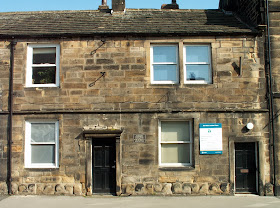At the junction with Bondgate and Crossgate is the War Memorial Garden where there is a replica of one of the Saxon crosses whose fragments are preserved in the Parish Church.
On the other side of Crossgate, The Old Cock is one of Otley's newest pubs.
The building was originally two cottages which were built in 1755 but in the late 19th century it was converted into one dwelling. In 2010 the fully restored building was opened as an independent real ale freehouse and in 2011and 2012 was named Leeds Camra pub of the year.
Crossgate leads to the bus station and thence to
the junction with Boroughgate.
Alongside the bus station at the end of Mercury Row is a
fine Georgian town house which dates to 1800 and which adjoins
a courtyard complex
Opposite the bus station in Nelson Street is the post office and a new library
which contains the tourist information desk
The bus station now forms part of a modern development, Orchard Gate,
with a courtyard which leads through to Newmarket, Market Street
and the Market Place.
The original bus station was built in 1938 by Legard's bus company and The West Riding County Council. Prior to the modern development there was no through road between Bondgate and Boroughgate.
Market Street
The northern side of the Market Place opens up onto Boroughgate which leaves the town on the Pool Road to the east.
There is the inevitable pub across the road. The Bay Horse which dates to the mid 1700's, gives its name to a passageway leading to another open courtyard. which we will visit in due course.
It is said that on one of his visits to
Otley Wesley's horse died and was buried in the churchyard. In his journal for Sunday 5th May
1782, Wesley wrote:
‘One of my horses having been so
thoroughly lamed at Otley that he died in three or four days. They buried him
in the Churchyard there being no other place. So Robert rests. Purchased another, but, it was his way to
stand still when he pleased, and set out as soon as possible.’Opposite the northwest corner of the Parish Church tower is a peculiar triangular stone, commonly known as the ‘Donkey Stone’ and maybe this was where the horse was buried.
Wesley visited Otley on about 20 occasions. First on 17th July 1759.
A nearby street is named after him.
Methodist churches were built in Nelson Street in 1771, now demolished and in Boroughgate in 1825, now part of Chevin Court. The present church was erected on a different site in Boroughgate in 1875 with a seating capacity of 1000.
Methodist Church and Church Hall
Methodist Church and Church Hall
On the opposite side of Boroughgate is the White Swan, formerly The Swan, a fine coaching inn with a date stone of 1901. It is a Grade 11 listed building. However, part of the pub is much older and probably dates as far back as the mid 18th century.
Boroughgate ends at Cross Green at the junction with Walkergate, where once upon a time there would have been a green space with a maypole. The maypole is still there but is now surrounded by a paved area in the midst of a busy traffic junction and known as Manchester Square.
In June 1871the maypole was struck by lightening and it was replaced
on May Day 1872.
The present maypole was erected in 1962 at a cost of £230.
It is 75ft high and 8ft below ground.
In order to protect the historic maypole, a small more modern pole
has been erected alongside.

It gets a good airing on May Day when the Town Crier makes a declaration.
The Otley Buttercross Belles
The most prominent building at this point is the former Mechanic's Institute, a Grade 11 listed building, which was built in 1870 in the modern Italian Style. This type of institute was provided in many areas by industrialists of that period to provide an educational environment for working men. It later became the Civic Centre but sadly closed in 2010 since which time it has been empty.
Back at other end of Boroughgate are crossroads with Kirkgate to the left and Westgate straight ahead. The Black Horse Hotel on the corner has long been a fine coaching inn providing accommodation for travellers well back into the 18th century, as it does today. It was rebuilt in its present style in 1901 and has recently been refurbished.
Westgate is of course the main route out of the town to the west towards Bradford and Ilkley. Little changed for over a century, it provides a variety of retail outlets which include the modern Waitrose supermarket.
Back at the crossroads,Manor Square leads us to the old Manor House.
On the opposite corner to The Black Horse is the former Royal White Horse Hotel, now converted into a bank and apartments. This imposing building was built in 1865 on an earlier foundation. It acquired its Royal prefix when Prince Arthur, Duke of Connaught stayed there in 1876. It closed down in 1973.












































No comments:
Post a Comment